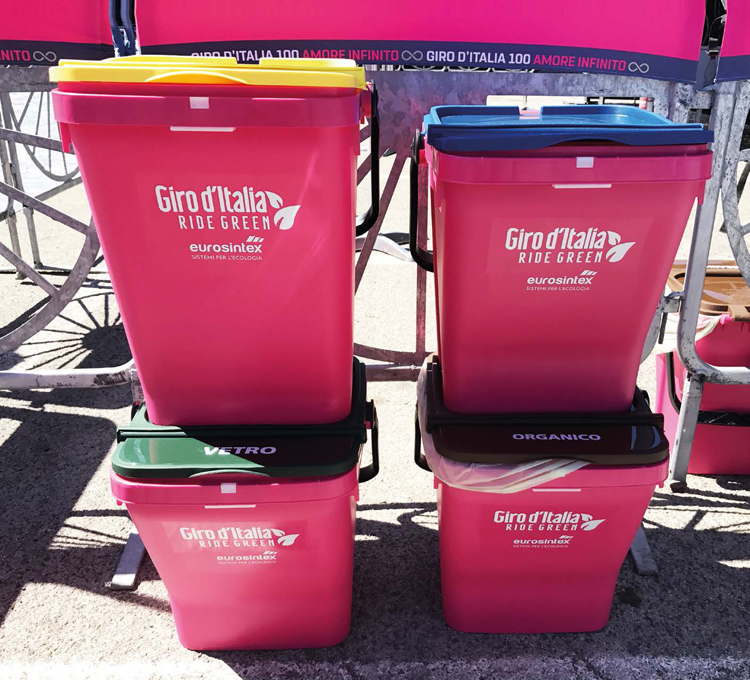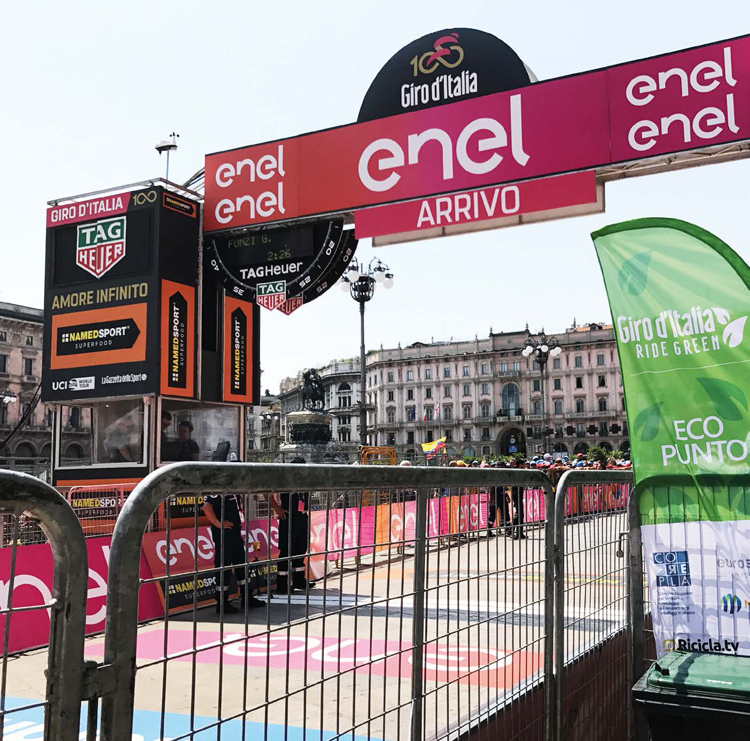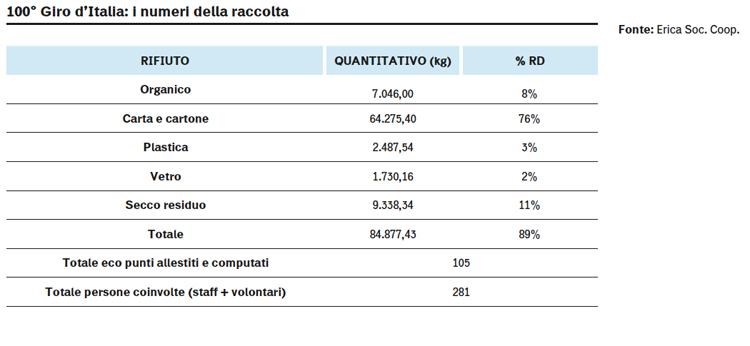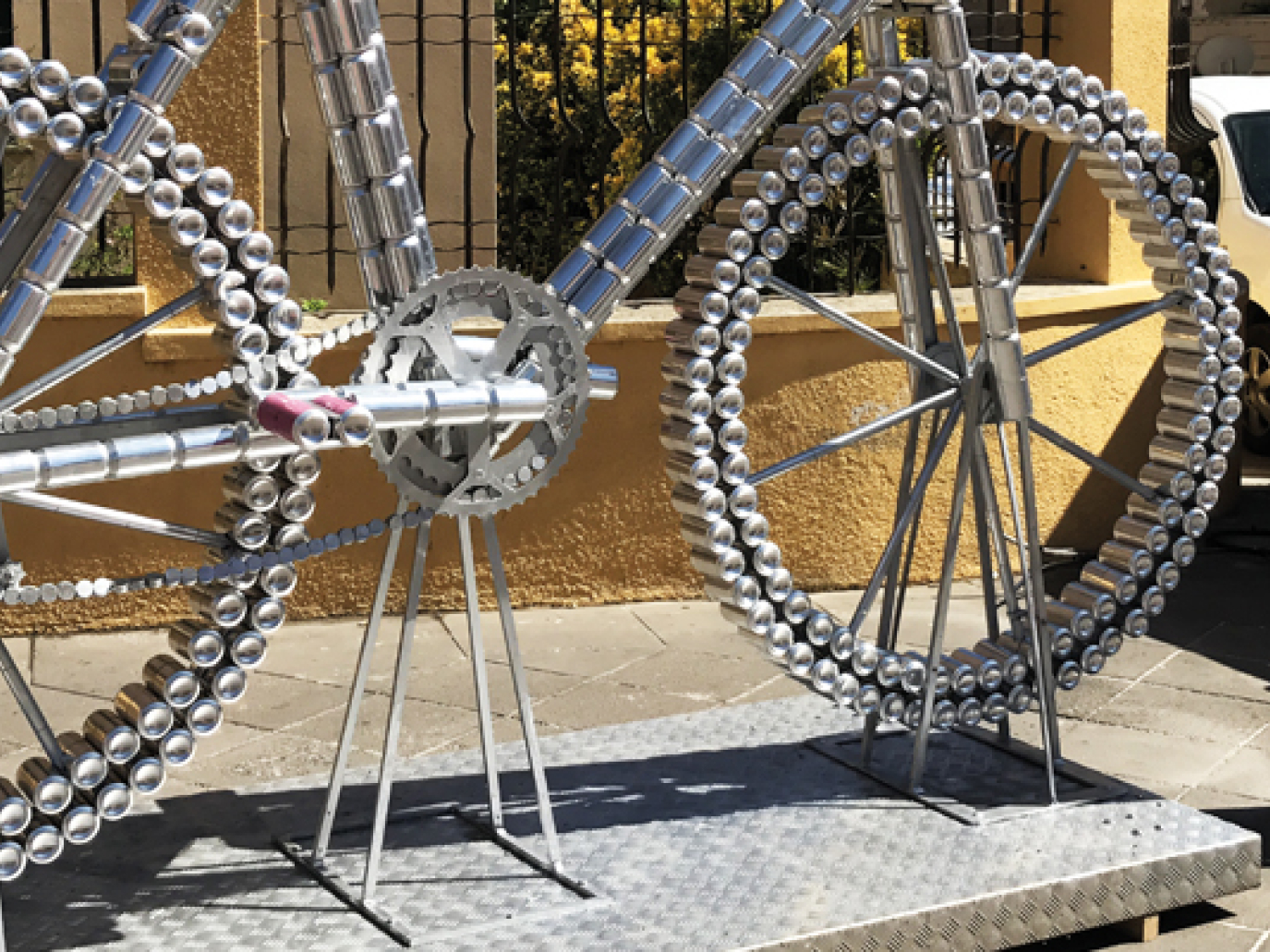With a contribution by Luigi Bosio (Engineering Office Manager, Erica Soc. Coop.), Roberto Cavallo (CEO of Erica Soc. Coop.) and Andrea Pavan (Ride Green Project Manager for Eric Soc. Coop.)
The Giro d’Italia has a history dating back almost 100 years, meandering through the roads of Italy, telling today’s Italy and Italians through unique images and impressive written words. Even today – when the Giro passes through – municipalities, volunteers, committees, companies, sports team leap into action. Thousands of people meet along its route, while millions more around the world see Italy thanks to live TV programmes, precious activity by social networks and RCS Sport media, the organizer of the event.
The Giro d’Italia 2016 edition started to tell a new story: that of a sustainable and environmentally-conscious Italy able – even during big events – not to waste and to recycle the rubbish it produces. Above all a story willing to communicate a new environmental culture, where materials are renewed and increase in value. A story of new objects manufactured from collected and recycled material, as is the case with aluminium bicycles produced from recycled cans.

Starting from 2016, RCS Sport chose a partner – Erica cooperative, an acronym that stands for Education, Research, Information and Environmental Communication – for the Ride Green project, aimed at helping the Giro d’Italia organizers make stages lighter and more sustainable, starting from used materials and the organization of separate waste collections along the whole route, in particular in the start and finish areas.
In late May 2017, in Milan, not only did the Giro’s 100th edition take place, but also a “competition” amongst municipalities that hosted the Giro and that competed over separate waste collection. A small competition that saw Erica’s engineers weighing materials every day – stage after stage, municipality after municipality, from Sardinia to Lombardy – while calculating the quantity of separate waste collection carried out during the Giro. Ride Green’s story is also made of small gestures accomplished every day by fans, the very cyclists and organizers.
Award-winning Municipalities in the July 2017 final event
Starts
Third: Tortolì with 83% of separate waste collection.
Second: Castrovillari with 84% of separate waste collection.
First: Forlì with 90% of separate waste collection.
Finishes
Second: Tortona, with 90% of separate waste collection.
First: Canazei, with 93% of separate waste collection.
Special mentions were also awarded to Municipalities that notably supported Ride Green:
- Municipality with most volunteers: Reggio Calabria.
- Municipality with the best project for social integration: Reggio Emilia (for the participation of refugees as volunteers thanks to the help of a social cooperative that receives them).
- Municipality with best participation of management company: Milan with AMSA.
Ride Green’s Key Words
The Idea
The project’s initial idea was simple: waste must remain at the centre of the areas where cyclists, sponsors and authorities are. The eco-waste collection points with containers for separate waste collection must be visible: even in photos, on TV, because they do not contain waste, but materials to be recycled. So the more visible and user-friendly they are, the more effective the service is. While at the beginning such proposal raised a few eyebrows, in the end those in charge of logistics, by working on the hospitality and open village maps, managed to arrange containers even in the most exclusive areas. Moreover, thanks also to the planning by engineering partners, multi-size containers have been produced to suit every context and with the Ride Green logo, able to differentiate the various materials collected. Erica’s staff dealt with the preparation of every stage, in every start as well as finish village. The rest was carried out by volunteers involved in every city by the Stage Committees and administrations, willing to help those who were not sure where to put a certain material.
People
The collaboration with Municipalities and businesses managing the public hygiene service was fundamental. They made sure that the materials collected during the event were recycled. Local partners had been contacted beforehand, they were explained the project and understood how separate waste collection was organized in every municipality, establishing where the various containers would be arranged in order to make them visible, without hindering the passage of vehicles. Getting volunteers involved, with the help of the Stage Committees and Municipalities, was not difficult. They explained how to carry out separate waste collection properly to cyclist fans that swarmed the start and finish areas, standing by the waste collection points throughout the event.

The Project
The service has been studied by Erica’s engineers based on the analysis of inputs (sampling types distributed by sponsors and the convoy, throw-away products used by catering etc.) and the separate waste collection services activated in the municipalities involved in the event. The two elements determined the choice of the type of containers, their number and distribution, with a view to recycling materials. The selected containers (specifically made by Eurosintex for the 100th Giro d’Italia) have been aggregated in collection points of the open village and hospitality centres and explained in various languages which materials would be recycled and where. Furthermore, a cooperative operator or volunteer made sure bin liners were replaced once they reached full capacity and stocked in designated spaces agreed with the Municipality. As for catering, thanks to the agreement and the help by Novamont S.p.A. supporting the project for the second year running, biodegradable and compostable flatware in Mater-Bi were produced, to be disposed of in the organic fraction of the separate waste collection and therefore sent for composting together with organic waste. While plastic materials have been recycled thanks to the support of Corepla, as well as all other separated materials.

Communication
Communication of the Ride Green project was studied using various types of media and new media. The project started with a press conference for the launch and the presentation of partners in Milan and ended with the award ceremony for the three best municipalities in terms of best results for separate waste collection, in the category of stage start and finish and with three special mentions. Throughout the Giro d’Italia communication focussed mainly on social media offering every day Ride Green data (amount of separate waste collection stage by stage) in the “Buongiorno Giro” (“Good morning Giro”) press release with the most important news of the previous day. Social media also contained more pop news like images of characters who acted as testimonials for the projects in the exclusive areas. A considerable contribution to communication was offered by Ricicla tv that followed the project broadcasting news reports filmed during the event and a final video with interviews with the protagonists of the race.
Sabox company, one of the partners of the 100% Campania project, manufactured all information panels for the village collection points in recycled cardboard, thus highlighting the message that what is correctly collected can enjoy a second life. This is all the more true for paper which is the most popular material in such events: closing the production chain loop with recycled cardboard products sends out a clear and important message on recycling. Last but not least, separate waste collection became a game that occupied spaces during the entertainment phases while waiting for cyclists to start or arrive, getting the general public involved in a game where they had to show how to carry out correct separate waste collection.
Results
During the 100th Giro’s 21 stages, both start and finish, Erica’s staff made of seven people together with volunteers weighed the collected materials, providing for each stage the data of the amount of organic, paper and cardboard, plastic, glass and non-recyclable waste. The table shows the end result of the separate waste collection throughout the event, with details on the amount of waste and the percentage of each fraction.
The Future
If in 2016 the Ride Green project was a gamble, in 2017 it became a certainty, with growing results and a tight-knit group that looked after the initiative on a daily basis. But in order to improve the sustainability of an event such as the Giro d’Italia, many more things can be done, working on input recyclability, waste reduction, energy saving and sustainable mobility. And above all a lot can be done to make the Giro convey environmental messages, as the very Ministry for the Environment that supported Ride Green suggested. Promotion of good environmental practices and local involvement will therefore remain key also for Ride Green 2018 edition.
Info
http://www.giroditalia.it/eng/ridegreen


